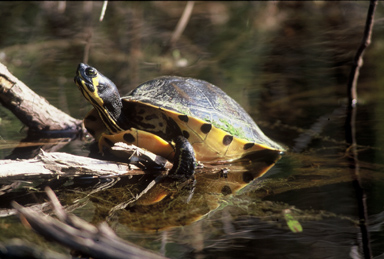Please see Part I of this article for general information concerning pet turtle shelters. Today we’ll look at meeting the needs of a few specialists.
Aquatic Bottom Dwellers
Mata Mata Turtles (Chelus fimbriatus), Snapping Turtles (Chelydra serpentina), Alligator Snapping Turtles (Macroclemmys temmincki) and some other aquatic species prefer to burrow under plants or mud, and rarely use caves. These turtles can easily be accommodated with Hagen Suction Cup-Equipped Plants. By positioning the suction cups so that the plant just touches the bottom of the aquarium, you can create a naturalistic shelter …several plants used in together can accommodate quite large specimens.
Shallow Water/Swamp Dwellers
 Bog Turtles (Clemmys muhlenbergi) and other retiring, shallow water species are usually most comfortable in heavily planted terrariums, with plenty of dead wood and moss available for hiding (please see photo). These will readily utilize artificial plants as well.
Bog Turtles (Clemmys muhlenbergi) and other retiring, shallow water species are usually most comfortable in heavily planted terrariums, with plenty of dead wood and moss available for hiding (please see photo). These will readily utilize artificial plants as well.
Large Tortoises
That 150 pound Spurred Tortoise you’ve raised will need a custom built “house”, but for most large terrestrial turtles, you can also use the Hagen plants described above. This actually suits tortoises quite well – in the wild most shelter within brush and under leaves, and not in “caves” per se.
Softshell Turtles
Softshell Turtles of all species are specialists, and do best when provided with fine sand in which to burrow. Although excellent swimmers, they prefer to shelter below sand in shallow water, so that they can breathe by merely extending their necks to the surface. Although sand complicates cleaning, most softshells fare poorly without it.
A Hundred Year Old Home
 You can also create your own shelters…broken clay flower pots are an old standby. The Common Musk Turtle (Sternotherus odoratus) pictured here has been with me for 40 years. It is posing before its very unique cave – a 100 year old tile from the roof of the Bronx Zoo’s Reptile House!
You can also create your own shelters…broken clay flower pots are an old standby. The Common Musk Turtle (Sternotherus odoratus) pictured here has been with me for 40 years. It is posing before its very unique cave – a 100 year old tile from the roof of the Bronx Zoo’s Reptile House!
Further Reading
The Eastern Spiny Softshell Turtle (Apalone spinifera spinifera) has specific habitat requirements in both captivity (please see above) and the wild, and is threatened throughout much of its range. A comprehensive recovery plan containing interesting natural history notes is posted here.
 Turtles that split their time between land and water are among the world’s most popular reptilian pets. Cooters, Red-Bellied Turtles, Yellow-Bellied Sliders, Reeve’s Turtles, Red-Headed Sidenecks and many other species can also be kept as described below. Please write in for specific information on these and other turtles.
Turtles that split their time between land and water are among the world’s most popular reptilian pets. Cooters, Red-Bellied Turtles, Yellow-Bellied Sliders, Reeve’s Turtles, Red-Headed Sidenecks and many other species can also be kept as described below. Please write in for specific information on these and other turtles. That Reptile Blog – Reptile, Amphibian and Exotic Pet Care and Information
That Reptile Blog – Reptile, Amphibian and Exotic Pet Care and Information

 Bog Turtles (Clemmys muhlenbergi) and other retiring, shallow water species are usually most comfortable in heavily planted terrariums, with plenty of dead wood and moss available for hiding (please see photo). These will readily utilize artificial plants as well.
Bog Turtles (Clemmys muhlenbergi) and other retiring, shallow water species are usually most comfortable in heavily planted terrariums, with plenty of dead wood and moss available for hiding (please see photo). These will readily utilize artificial plants as well. You can also create your own shelters…broken clay flower pots are an old standby. The Common Musk Turtle (Sternotherus odoratus) pictured here has been with me for 40 years. It is posing before its very unique cave – a 100 year old tile from the roof of the Bronx Zoo’s Reptile House!
You can also create your own shelters…broken clay flower pots are an old standby. The Common Musk Turtle (Sternotherus odoratus) pictured here has been with me for 40 years. It is posing before its very unique cave – a 100 year old tile from the roof of the Bronx Zoo’s Reptile House!